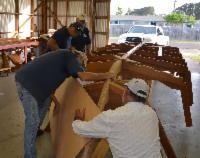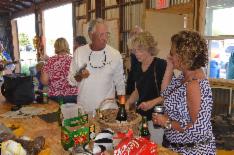
As summer 2013 arrived and our boat building adventure at Farley Boat Works in Port Aransas drew closer I grew more and more apprehensive. In wood shop as a high school student I had the most difficult time building a simple three piece book holder. When the guidance counselor reviewed my vocational evaluation test results I do not recall being pointed in the direction of any of the skilled crafts. In spite of this as an adult I would wander the aisles of the home improvement stores buying tools I hoped someday to use a second time. My favorite websites usually have something to do with wooden boats though.


The Farley Boat Works of Port Aransas an offshoot of the Port Aransas Museum was established in 2011 and I wandered in a few months later. There I discovered local men engaged in the fine art of wooden boat building. Certain I would be totally out of place I steeled myself for the disappointment that was surely in my immediate future.
Instead I found a group of helpful friendly people. So with confidence I do not normally have when approaching the simplest of home repairs I signed up my then 16 year old son, Joey, and myself to build a boat this summer. To maintain that confident level of optimism every conversation for the last year probably contained a small bit about the Farley Boat Works. I would mention how we would be building a boat there. The questions were always the same. "Do you know how to build a boat?" My answer was always the same. "I don’t but the folks at the shop do, would you like to help us?"
Even though a lot of people expressed an interest we didn’t have anyone with us when we showed up the last Monday in July only to find out the shop is open Tuesday through Saturday. Planning ahead requires paying attention to the details I reminded myself. Since at least 85% of life is showing up we returned early Tuesday morning.
Our immediate goal we learned after meeting with Shop Master and lead boat builder Darrell Lynn was to help him complete a 20 foot center console craft. Burt Moorhouse and his wife Beverly Bolner greeted us as Darrell directed us to the bow of their boat where we held the gunwale in place. Burt began clamping the mahogany into place. After fitting the piece on the port side we jumped over to the starboard side and began the process again.
Following the fitting we removed the clamps, Darrell mixed some two part epoxy, coated the parts, refitted the gunwales as we held them with all of our hand strength as the stainless steel screws were drilled into place. We had arrived.
With a shared experience my son and I were now officially one step closer to building and launching our very own Farley boat. We had shown up a few days early to assist on other boat projects to acclimate ourselves and to be a part of the process of helping other boat builders achieve their dream as well.
Darrell Lynn is from UP… or the Upper Peninsula of Michigan. He had recently attended a wooden boat building program to continue his own growth in the craft. A former body builder who still carries himself with the quiet machismo of someone who has spent long hours lifting weights and running his own gym. But it is his easy going manner that makes him a great shop master. He can also yell out instructions louder than any shop machine that happens to be running while he is talking.
"OK, Joey, we are going to grab some of these boards here and start getting some transoms built." Darrell called out as Burt and Beverly began sanding their project. Before we could react Darrell began pulling out a huge 20 foot long mahogany board that took several of us to lift up. "OK, get me three pieces 36" inches long" he continued before heading off to check on something in one of the storage units.
Pat Farley, a board member of the Port Aransas Historical Association and owner of a local jewelry shop, The Silver King, smiled as we appeared to be taken back by the direction. "Let’s take this over there." he nodded to the radial arm saw.
With the nearest tape measure in hand and my son closely watching I marked three sections to cut from a piece of timber that surely cost a pretty penny. A few moments later after a quick lesson on how to adjust the angle of the saw blade I grabbed the handle, depressed the trigger, said a little prayer and cut the lumber. It was at that moment a voice inside my head reminded me to measure twice and cut once. "Ah, that was a little late." I said out loud. Pat and Joey just looked at me.
Having managed to successfully chopped our first three boards Pat and Joey headed over to the planner to run them through. The planner takes the roughness off the board making them easier to work with and giving them a nice smooth finish. More importantly the planner mills the board to a consistent thickness.
It was at this point that Darrell called me over and if I could have remembered what his instructions were then I would have followed them and been able to write them down now. But after his words buzzed through the air along with the sound of Joey and Pat operating the planner I just looked at Darrell and nodded.
One of my favorite quotations from the Art of War by Sun Tzu, a Chinese general who died more than 1000 years ago is "In the midst of chaos there is also opportunity." I took that opportunity to go help Joey and Pat.
Pat is a descendant of the original Farley brothers who built tarpon boats and Texas coastal skiffs for decades right there in the very shop in which I stood. He is committed to the concept of the Farley Boat Works goal of establishing the shop as a respected non-profit center of wooden boat building. So as Joey and Pat finished milling the boards the three of us walked over to the work benches where Pat set us on the first step of Darrell’s instructions.
Over the next three days we continued to work Burt and Beverly’s boat, construct three front stems and three transoms for our boat and two future boat builds. We learned how to mix epoxy, spread it on a boat’s keel and cover it with fiberglass. We were sanding, gluing and screwing boards together with more confidence as we went along. We remembered to measure twice, cut once and pre-fit before gluing. We learned to scarff. What is scarffing? Scarffing plywood is sanding back the layers from one edge 6-8 inches exposing the underlying layers at an angle so two pieces can be glued together to create one long sheet of plywood.
We would start at 9am, break for lunch, oh, scarffing is also a term for eating pizza fast but our lunches were relaxed and talk centered around building boats after which we would return, break for a siesta, return and finish about 9pm and head for dinner where we drew a few looks for being covered in wood stains and probably stinking. Loving it.